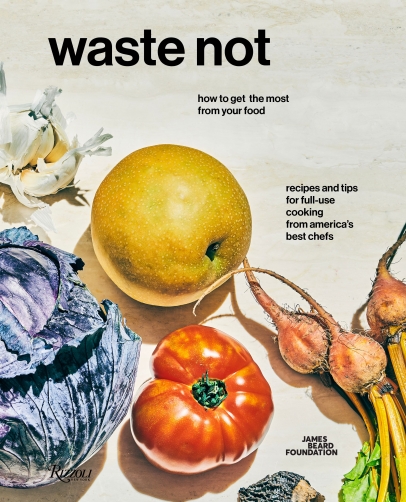WASTE NOT: How to Get the Most From Your Food
Carrot tops. Broccoli stalks. Radish greens. Overripe avocados. Wilted celery. Fish skin.
What may look like castoffs to a home cook is gold to a chef. Or your grandmother.
The James Beard Foundation has produced Waste Not: How to Get the Most from Your Food, a compilation of 100 recipes gathered from more than 60 acclaimed movers and shakers on the front line of creative residuals diversion. These chefs advocate not only nose to tail but stem to leaf, seed to skin, crust to crumb. And with Vermont’s universal composting requirement as of July 2020, this book will provide elegant solutions to transform scraps into specialties.
Carrot or radish top pesto, kale stem crackers, broccoli stalk vinaigrette, pickled watermelon rind, squash seed tahini. Divert these essentials from the compost and taste the glory of frugality.
Core Values Chutney combines cores, stems, and leaves of broccoli, cauliflower, and cabbage mixed with fresh herbs, citrus, and any nuts you have on hand. Kitchen Scrap Kimchi also repurposes those leftover bits of cabbage, kale, chard, and beets and blends them with alliums, ginger, daikon radish, fish sauce, and Korean chile powder. Leftover Doughnut Crème Brûlée happily rescues any stale pastries or breads because let’s be honest—who has leftover doughnuts? Roasted Vegetable Spread transforms tired or bruised eggplant, summer squash, peppers, onions, and herbs into a deeply flavored mélange ideal to smear on a sandwich or to offer as a veggie dip.
Even after zesting and juicing your citrus, there’s still life in those pliable domes! Store them in a jar of distilled white vinegar for a couple of weeks, then simmer gently in a bit of sugar. The resulting Citrus Vinegar is perfect for marinades or shrubs, a nonalcoholic syrup made from a combination of concentrated fruits, aromatics, sugar, and vinegar. Looking at a couple of overripe avocados on your counter? Blend them with agave and high-quality cocoa powder to make a luscious, dairy-free pudding ready for a sprinkle of toasted nuts or sliced strawberries.
Leeks literally get short-changed by recipes calling for just the white and light green portion. Creamed Leek Tops, a redolent riff on creamed spinach, celebrates the immense flavor and texture of those darker ends. In Green Top Harissa, the traditional brick-red paste morphs emerald green thanks to radish and beet tops and plenty of parsley and cilantro stems. Stir it into yogurt for a dipping sauce, use it as a marinade for chicken, or spread over turkey burgers.
Carrot Spaetzle honors the carrot in all her glory. The plump spaetzle turn pale green from blanched carrot tops blended into the dough; long carrot peels are quickly fried in canola oil until crispy; carrot coins are sautéed in butter, garlic, and onion. Use rainbow carrots for the most visually arresting effect. Sofrito sweet potato hash, the ultimate comfort dish, marries roasted sweet potato chunks with blitzed aromatics including alliums, herbs, hot and sweet peppers, honey, and olive oil.
Each section is preceded by a handful of chef tips that seem obvious, once you’ve read them. For instance, when salad greens start to wilt, sauté them with olive oil and garlic for a bright side dish. You can re-grow rooted ends of scallions and leeks in clean water on your windowsill. And save your leftover pickle liquids, boil the combined brine, pour into a glass jar of cut-up chopped veggies, and voila, you’ve made your own quick pickles.
Any chef considers it a travesty to discard scraps that could be repurposed to culinary benefit. This beautiful book by the James Beard Foundation inspires readers to take that same approach in our own home kitchens. Just like our grandmothers did.
VEGETABLE SALAD WITH PICKLE VINAIGRETTE
By Abra Berens
This salad sucks up any odds and ends in the fridge, from veggies that are best roasted (like potatoes or cauliflower) to those better off raw, to herbs and even fronds or tops. The dressing is a simple combination of sour cream and liquid from anything pickled.
Yield 5 servings
- 5 fingerling potatoes, cut into wedges ¼ medium head cauliflower
- 2 teaspoons olive oil
- Salt and pepper to taste
- 3 radishes
- 2 medium carrots, peeled
- ½ large head fennel
- ¼ medium head purple cabbage
- ½ bunch parsley, roughly chopped ½ bunch cilantro, roughly chopped ½ cup sour cream
- ¼ cup pickle liquid
Heat the oven to 400 degrees.
On a rimmed baking sheet, toss the potatoes and cauliflower with the olive oil and salt and pepper to taste. Roast until crispy outside and tender inside, 20 to 25 minutes.
Shave or cut the radishes, carrots, fennel, cabbage, and cauliflower thinly with a knife or mandolin.
In a large bowl, whisk together the sour cream and pickle liquid. Add the raw and roasted vegetables and chopped herbs and toss together. Season with salt and pepper to taste. Taste and adjust the seasoning and acidity as desired.






